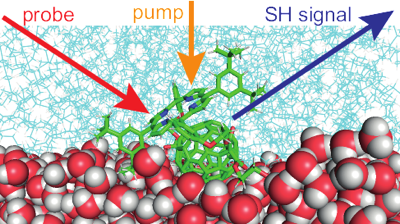-
Photoinduced Electron Transfer in a Porphyrin-Fullerene Dyad at a Liquid Interface
J. Sissaoui, A. Efimov, T. Kumpulainen and E. Vauthey
Journal of Physical Chemistry B, 126 (2022), p4723-4730


DOI:10.1021/acs.jpcb.2c02405 | unige:161827 | Abstract | Article HTML | Article PDF | Supporting Info

The excited-state properties of an amphiphilic porphyrin-fullerene dyad and of its porphyrin analogue adsorbed at the dodecane/water interface are investigated by using surface second-harmonic generation. Although the porphyrin is formally centrosymmetric, the second-harmonic spectra of both compounds are dominated by the intense Soret band of the porphyrin. Polarization-selective measurements and molecular dynamics simulations suggest an angle of about 45° between the donor-acceptor axis and the interfacial plane, with the porphyrin interacting mostly with the nonpolar phase. Time-resolved measurements reveal a marked concentration dependence of the dynamics of both compounds upon Q-band excitation, indicating the occurrence of intermolecular quenching processes. The significant differences in dynamics and spectra between the dyad and the porphyrin analogue are explained by a self-quenching of the excited dyad via an intermolecular electron transfer.